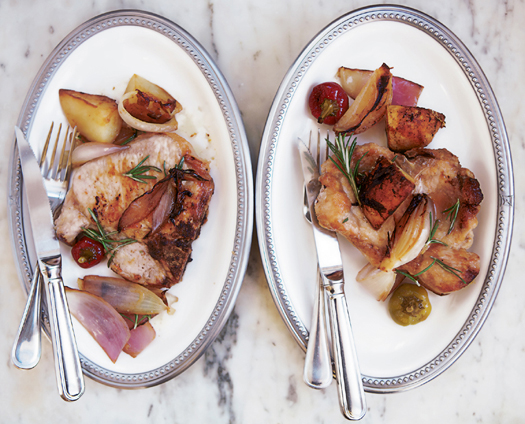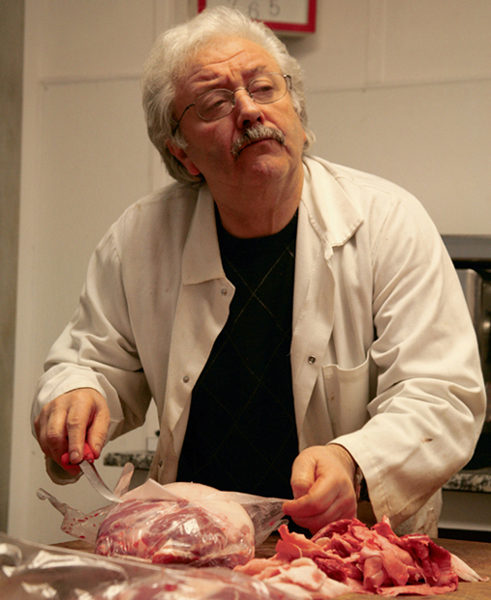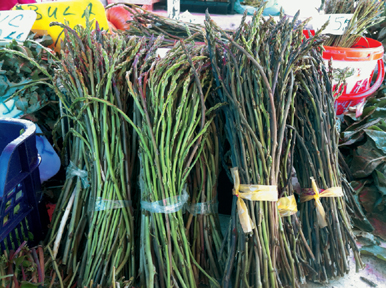 PORK
PORK PORK
PORKI visit St. Louis often, to do events, go to conventions, and host dinners that showcase Bastianich wines. It is not too far from Kansas City, where we have our restaurant Lidia’s, so when I visit the restaurant I make a trip to St. Louis as well. In St. Louis I have good friends in the Bommarito family: Tony Bommarito and his son, wine distributors, make sure that the Bastianich wines are available in St. Louis and, for that matter, in all of Missouri. Tony and his brother Vincent and family run Tony’s restaurant, where I have had many a delicious meal, and Vincent, his wife, Martha, and I have been known to travel to Italy together to explore and find new Italian flavors and products to bring back to our restaurants. St. Louis has a great Italian heritage, and there are many good Italian restaurants to dine at. Some of my favorites are Cunetto House of Pasta, Trattoria Marcella, LoRusso’s Cucina, Dominic’s, Giovanni’s on the Hill, Rigazzi’s, and Charlie Gitto’s.
My most recent trip was purely for research. We knew there was a strong Italian American community there, known as “The Hill,” and Tanya and I were determined to get to know it. Armed with a detailed street map, we took a cab from downtown St. Louis and ended up on Marconi Avenue. The streets were lined with small houses, most of them with fenced-in yards and small porches. On our walk, I could almost hear the humming of conversation on those porches as it would have been in its Italianissimo days, 1900 to 1950.
And indeed I did hear a tender voice calling, “Lidia … Lidia, is that you, Lidia?” Rocking on a small chair was a woman with a wide-brimmed straw hat, gray strands of hair streaming out to frame her kind, gentle face with its welcoming smile. A large pin of the Madonna adorned the left shoulder of her blue sweater. A black Labrador began barking and wagging his tail as she addressed us. “Lidia, I have been watching you for years. Come!” Slowly we approached and climbed onto the porch. As we talked, I learned that Anna Feronato, seventy-nine, had lived with her parents, Gilda and Domenico, on The Hill. They came to the United States from Vicenza, in the Veneto region of Italy. Most of the immigrants on The Hill were from Lombardy and Sicily.
She was born and raised in the small house across the street, which she pointed out to us. “It had two rooms, and we were five kids. I slept with my sister until the day she got married, and when she left, I felt like a piece of me had left with her. We all grew up to be good people, and in turn raise good families. The shoemaker lived two houses down, the baker three houses up, and the street was always full of children playing.”
The church bells rang as we talked, the sound coming from not too far away. Anna informed us it was the bells of St. Ambrose Church, the church built by the immigrants—the center of the community, where everybody gathered to pray, to celebrate, to be grateful, and to help new immigrants. A bronze statue of an immigrant family graces the entrance to the church now. Ah, now it’s clear—St. Ambrosio, the patron saint of Milano, the capital of Lombardy, always longing for home.

Let’s meet in St. Louis!
We said goodbye to Anna, and since it was lunchtime, Tanya and I headed for the oldest Italian restaurant on The Hill, Rigazzi’s, just down the road from Anna’s house. It was on their menu—among “Italian-Stuffed Pork Chops,” “Pasta 3 ways—Ziti, Ravioli, and Cavatelli” with a slice of garlic bread—that we encountered the “Parmiciano” sandwich. It was a delicious tender veal cutlet topped with savory tomato sauce and melted mozzarella. However, one major observation: the cutlet was made of chopped veal, then breaded and fried. It was a first for me—a cutlet made of chopped meat?
It all became clear a few months later, when I went to Memphis to do a dinner and a book signing at a fund-raising event for the Brooks Museum of Art. The morning before the event, Thayne and Anne Muller, the chairs of the event, took me to breakfast. The best breakfast in Memphis was to be had at the Cupboard, which the Cavallo family has been running for generations. We had grits and sausages, country-ham steak with red-eye gravy, biscuits with white gravy, and a country-fried steak. All was delicious, but what intrigued me most was the fried steak—chopped beef made into a flat patty, then breaded and fried. As they explained it, country-fried steak is an old tradition in the South.
St. Louis came back to mind. Those Italian immigrants must have experienced the country-fried steak somewhere, and ingeniously used the technique of chopping less expensive and tougher cuts of veal to turn it into a “veal cutlet.” Ingenious indeed, and most likely how the “Parmiciano” came to be.
I found the story of the St. Louis pizza quite interesting, so I had to go to Imo’s Pizza, opened in 1964 by Ed and Margie Imo, where supposedly this pizza was born. It was indeed different from any pizza I had had before: here the pizza crust has a texture between a cracker and shortbread. Piled on top is a unique cheese mixture, a response to the memory of the milky-velvety mozzarella cheese found on pizza in Italy. Legend has it that the original owner of Imo’s, Ed, used to lay tile for a living and so was accustomed to cutting things into squares—thus the distinctive shape of the slice.
Another Italian family institution in St. Louis is Volpi—“the taste of Italy since 1902”—producers of prosciutto, salami, and cured meats. It was important to immigrants to keep a traditional Italian table. How could they set up an Italian table for Sunday dinner without prosciutto? Immigrant artisans who had the talent, like the Volpi family, opened small businesses and turned them into national and international conglomerates. The Volpis hailed from around Modena, the epicenter of Italian prosciutto curing, where Prosciutto di Parma comes from, and knew the tradition of curing prosciutto well.
When I was a child, every November, almost like a ritual, my family saw to the slaughter of the pig that my grandmother had been feeding all year. It was a time to celebrate, because that one two-hundred-kilogram animal would provide the means to feed the entire family for the next year. We made prosciutto out of the two hind legs, spaletta (a skinnier, less prized version of prosciutto) out of the two front legs, pancetta from the belly, and ombolo (cured filet preserved in rendered fat, along with the dried sausages, to remain moist). Whenever my grandmother got cooking, she would dig into the solid rendered fat and fish out a fat-covered piece of the cured meat; with that she would begin browning her soffritto, which became the base for a sauce or a soup. I especially liked it when she would cut up the ombolo or sausages in small pieces, lightly brown them in the rendered fat, and then throw in a few whisked eggs just gathered from the chicken coop and serve it with a slice of her country bread. Life was good.…
Every bit of the animal was used. We made sanguinaccio (blood sausage), regular sausages, musetto (head cheese), cured hoofs, ears. Even the tail was cured, and the bladder, after some drying out, was turned into a soccer ball for the boys. So I understand how prosciutto is essential to the Italian family table, and how the Volpi family prospered with their products. Today Prosciutto di Parma, as well as the prosciutto from San Daniele di Friuli, the region I hail from, is imported and readily available in the United States. But the Volpi family continues to do well and produce diversified cured-meat products in St. Louis.

I am sure all of you have had some version of sausage and peppers, but this one is easy to make, and the sausages remain juicy. The idea is to cook the sausages and vegetables separately, and then combine them at the end. Even though sausage and peppers seem to be quintessentially Italian, peppers are a New World food and were introduced to Italy only after the discovery of the Americas. Italians quickly made them their own and incorporated them on their table. So, when they came to America as immigrants, peppers were abundant and used with excess in many of the Italian American dishes. They are now ubiquitous at every Italian street fair.
SERVES 6 TO 8
2 tablespoons extra-virgin olive oil
12 sweet Italian sausage links (about 3 pounds)
8 garlic cloves, crushed and peeled
4 hot pickled cherry peppers, stemmed, halved, and seeded (leave some of the seeds in if you like the heat)
3 small onions, peeled, cut into wedges attached at the root end
1 pound mixed mushrooms, halved (button, cremini, shiitake)
3 red, yellow, or orange bell peppers, quartered, or cut into sixths if large
½ teaspoon kosher salt
Heat the olive oil in a large skillet over medium heat. Add the sausage, then cover and cook, turning occasionally, to brown all sides, about 10 minutes in all. Uncover, add the crushed garlic and cherry peppers, cover, and cook until the sausages are cooked all the way through, about 10 minutes more. Remove sausages to a plate.
Add the onion wedges and cover the skillet. Cook, tossing occasionally, until the onions begin to caramelize on the edges, about 5 minutes. Add the mushrooms and bell peppers, season with the salt, stir, and cover. Cook, stirring occasionally, until all of the vegetables are tender, about 10 minutes more. Uncover, increase heat to get the pan juices simmering, and cook until the juices have reduced and glazed the vegetables, about 10 minutes.
Return the sausages to the skillet. Cook and toss to heat the sausages through and combine flavors, about 3 minutes more.

This is one of those one pot meals that bring spice and a lot of flavor to the table. It is a traditional method of cooking and combining ingredients, especially in southern Italy, and many restaurants have it on their menus, especially those in the Little Italys across America. This method of adding the cherry peppers, potatoes, and vinegar can be used with chicken or rabbit, too. The spice gives the dish its “capricious” name.
SERVES 6
Six 8-ounce bone-in pork loin chops, about 1 to 1½ inches thick
2½ teaspoons kosher salt
All-purpose flour, for dredging
2 tablespoons extra-virgin olive oil
2 tablespoons unsalted butter
4 garlic cloves, crushed and peeled
6 pickled hot cherry peppers, halved and seeded (or leave some seeds in for more heat)
1½ pounds russet potatoes, peeled and cut into 2-inch chunks
2 sprigs fresh rosemary
2 red onions, peeled and cut into eighths
½ cup white-wine vinegar
Season the pork chops all over with 1 teaspoon salt. Spread the flour on a plate, and dredge the chops in flour, tapping off the excess.
Heat the oil and butter in a large skillet. When the butter melts, slide in the chops and brown on one side, about 3 to 4 minutes over medium heat. Turn the chops, and plop the garlic cloves in the spaces between them in the pan. When the garlic starts to sizzle, drop in the pickled cherry peppers, and let sizzle until the chops are browned on the second side, another 3 to 4 minutes.
When the chops are browned, push them to one side of the skillet and add the potatoes. Season the potatoes with 1 teaspoon of the salt, and sprinkle in the rosemary needles and the red onions. Cover the skillet, and cook, gently turning everything occasionally, until the onions and potatoes are almost tender, about 12 to 15 minutes.
Pour the vinegar into the skillet. Cook, covered, until the potatoes and onions are tender and the chops are cooked through, about 5 minutes more. Uncover, and season with the remaining ½ teaspoon salt. If the sauce is too liquid, remove chops to a plate, increase heat to high, and boil until the sauce is thickened to your liking. Pour the sauce over the chops.
Pork meat, which is nutritional and economical, is used a lot in Italy. Using the tenderloin for this dish guarantees a tender result, but one can use boneless shoulder or leg meat instead, cutting it into thin slices. You can also make this dish with chicken breast or boneless chicken legs. The sun-dried tomatoes bring a lot of flavor to the dish; I use them whole, or sometimes purée them in a processor and spread the paste on the meat, but in this recipe I slice them.
SERVES 6
2 pork tenderloins (about 2 pounds total)
½ teaspoon kosher salt
12 oil-packed sun-dried tomatoes, drained, sliced into ½-inch pieces
4 ounces prosciutto, thinly sliced
2 tablespoons unsalted butter
2 tablespoons extra-virgin olive oil
All-purpose flour, for dredging
6 to 8 large fresh sage leaves
20 ounces cremini mushrooms, thickly sliced
Cut each pork tenderloin crosswise, on the bias, into six equal slices—twelve slices in all. Pound each piece of pork to an even thickness of about ½ inch, using a meat mallet. Season the pork on both sides with the salt.
Lay the pork slices flat on your work surface, and evenly place the sliced sun-dried tomatoes on top. Layer on the sliced prosciutto, cutting or tearing it to fit on the pork slices without draping over the sides. Roll up the pork lengthwise, enclosing the filling, and secure with toothpicks.
Melt the butter and the oil in a large skillet over medium-high heat. Pour the flour onto a plate. Dredge the pork rolls lightly in the flour, tapping off the excess. Sear the pork in the skillet on all sides, about 8 to 10 minutes in all, then push the pork to one side of the pan and toss in the sage leaves. Once the sage is sizzling, add the mushrooms, and cook until they are starting to brown, about 3 to 4 minutes. Redistribute the pork rolls evenly in the pan with the mushrooms, then cover the skillet and lower the heat. Simmer until the mushrooms have given off their juices and the pork is tender, about 10 to 12 minutes.

Domenico Susi at Sulmona Meat Market in Boston
Rollatini are a popular dish in Italy. They can be made with chicken, veal, or pork, and the stuffing can be just about anything you like, but do include cheese. The delight of rollatini is the oozing cheese when you cut into them. So, whatever you do, do not skimp on the cheese.
This dish was very popular on the menus of Italian American restaurants in the sixties and seventies. Fontina has great melting qualities; when it is not readily available, Muenster cheese is often substituted.
SERVES 6
1½ teaspoons kosher salt, plus more for pot
12 medium asparagus spears
1 cup chicken stock
¼ cup dried porcini
2½ pounds boneless pork loin, trimmed
2 plum tomatoes, seeded and sliced into thin strips
8 ounces Italian fontina, cut into thin strips
1 tablespoon chopped fresh Italian parsley
All-purpose flour, for dredging the pork
6 tablespoons unsalted butter
2 tablespoons extra-virgin olive oil
8 fresh sage leaves
1 pound mixed mushrooms, sliced (button, cremini, shiitake, chanterelles, etc.)
1 cup dry white wine
Preheat oven to 450 degrees F.
Bring a medium pot of salted water to boil. Slip in the asparagus, and blanch until crisp-tender, about 3 minutes. Run the asparagus under cold water and pat dry. Bring the chicken stock to simmer in a small pot, then add the dried porcini and remove from heat. Let soak.
Slice the pork crosswise into twelve slices. Pound the pork slices to an even ½-inch thickness with a meat mallet. Season the pork with ½ teaspoon salt. Lay the pork on your work surface, and evenly divide the tomato strips on top, lining them along the longer side of the pork slice. Put an asparagus spear on each slice, and cut to fit on the meat. Divide the fontina evenly among the pork slices, and sprinkle with the parsley. Roll up the pork snugly around the asparagus, tomato, and cheese, tucking the ends in, to enclose the filling. Close each roll with a toothpick or two.
Drain the porcini from the broth, reserving the soaking liquid, and coarsely chop. Spread the flour on a rimmed plate. Dredge the pork rolls in the flour, tapping off the excess. Heat 3 tablespoons of the butter and the oil in a large Dutch oven over medium heat. When the butter is melted, add the pork rolls and brown on all sides, about 5 to 6 minutes. Remove the browned rolls to a plate.
Toss the sage leaves into the Dutch oven. When the sage is sizzling, add the sliced fresh mushrooms and chopped porcini. Season with the remaining 1 teaspoon salt, and sauté until the mushrooms are browned and softened, about 6 minutes. Pour the white wine into the Dutch oven with the remaining 3 tablespoons butter. Bring to a boil, and let the wine reduce by half, about 2 minutes; then pour in the porcini soaking liquid. Bake the pork, uncovered, until cooked through, about 18 to 20 minutes. If the pork is cooked but the sauce is too thin, remove the pork to a plate and reduce the sauce on the stovetop. Remove toothpicks before serving.

Wild asparagus, like these from the market in Pula in Croatia, are perfect for this dish.